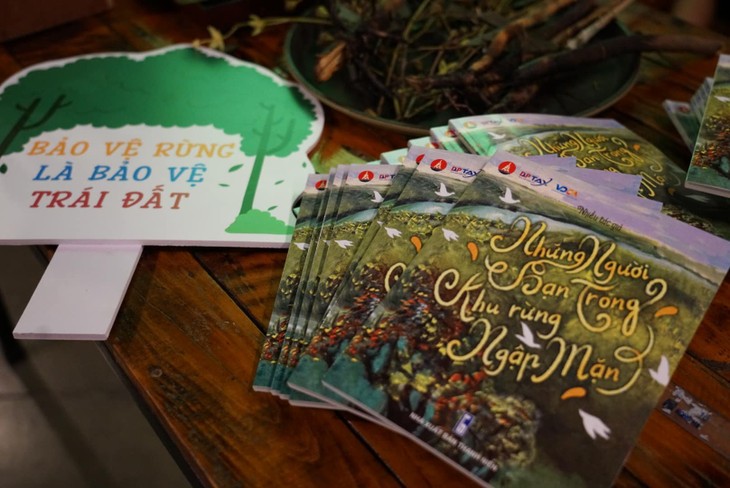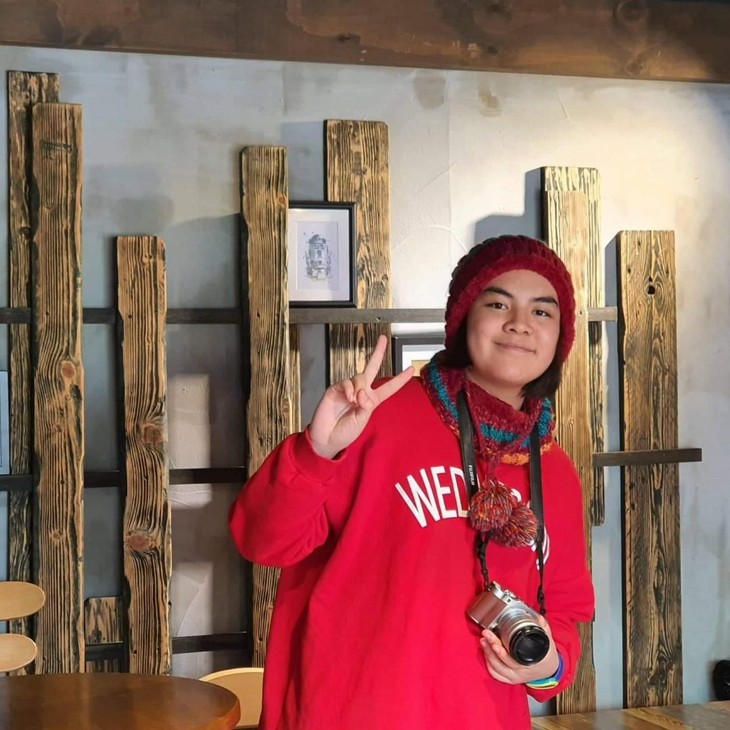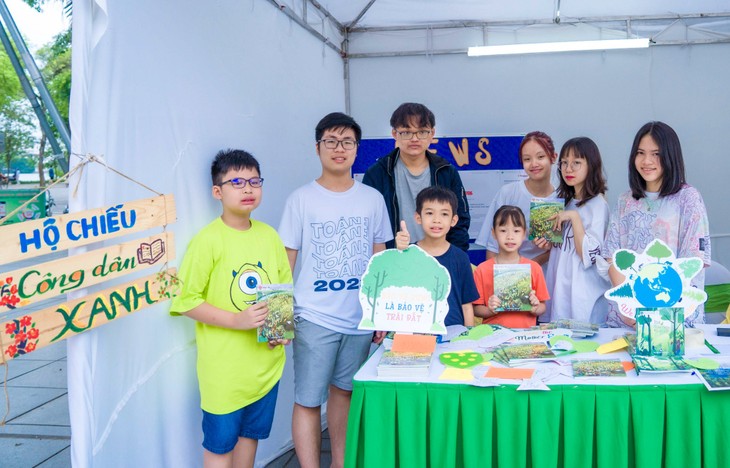(VOVWORLD) - “Mangrove Xuan Thuy” is a fundraising project for mangrove conservation in Xuan Thuy National Park in Nam Dinh province. Initiated by 15 Vietnamese students living in Hanoi and New Zealand, “Mangrove Xuan Thuy” was one of several environmental-friendly projects introduced at a ceremony in Hanoi to kick off this year’s Action Month for the Environment. To find out more about the project, I talked to Pham Ngo Hoang Lan Elizabeth, a Vietnamese-New Zealander at Macleans College in New Zealand, who was one of the project’s founders.
 “Friends in the Mangrove” books on display at ACCB’s environmental coffee event (Photo credit: Hoang Lan Elizabeth) “Friends in the Mangrove” books on display at ACCB’s environmental coffee event (Photo credit: Hoang Lan Elizabeth) |
Why did you decide to create the "Mangrove Xuan Thuy" project?
I’m fascinated by wildlife and spent much of my childhood painting nature’s creations, like the endangered Edward’s pheasant and the Asiatic black bear, for the WWF (World Wide Fund for Nature) calendar. I’m one of many environmentalists around the world who want to conserve their community’s biodiversity. Nguyet Linh, my co-founder, shares this passion. Our own observations and the daily news made us recognise that deforestation is a major problem in our communities. We knew we had to act, so we developed “Mangrove Xuan Thuy.”
 Pham Ngo Hoang Lan Elizabeth Pham Ngo Hoang Lan Elizabeth |
What are the project’s objectives?
Our general objective is to conserve the mangrove ecosystems of Xuan Thuy National Park, Nam Dinh, Vietnam. To do that, we outlined two sub-objectives: rally our communities for mangrove tree-planting trips and raise public awareness about mangrove ecosystems. The steps we have taken to reach our objectives are to raise money with artworks and to create a tangible product that increases public knowledge of Xuan Thuy National Park and educates readers about the Park’s distinct fauna and flora.
Well it sounds interesting. Could you give us some details?
“Mangrove Xuan Thuy” is a mangrove conservation project supported by Xuan Thuy National Park which operates under the guidance of the Parent-Led Climate organization in Vietnam. The project was started last August by Nguyet Linh and me. We initially planned to fundraise for 200 mangrove trees in our local community and on social media, incentivising donors with my wildlife artwork. We were ecstatic when we surpassed our initial goal and received funding for 291 mangrove trees. To expand our project’s impact, 13 more environmentalists joined us and “Mangrove Xuan Thuy” grew into be an organisation of 15 youths between 8 and 17 years old from Vietnam and New Zealand. With members representing several schools in Hanoi, including the High School for Gifted Students in Social Sciences and Humanities, the Marie Curie Hanoi School, and the Wellspring International Bilingual School, every discussion is filled with thoughtful ideas.
Why did you choose Xuan Thuy National Park rather than other places in Vietnam to implement the project?
Xuan Thuy National Park, Vietnam's first declared Ramsar site, is one of the most important mangrove forests in Vietnam because of its great biodiversity in ecosystems and species (1646 species!) It’s an essential stop for international migratory birds, including the endangered Black-faced Spoonbill, listed in the International Union for Conservation of Nature’s Red List of Threatened Species. Xuan Thuy National Park is one of two core areas of the Red River Delta Biosphere Reserve.
What results have you gotten so far since you launched the project last August?
We’ve surpassed our phase 1 objective of raising enough money to plant 200 mangrove trees in Xuan Thuy National Park by an additional 91 trees. As of 12 June 2022, our Facebook fanpage has nearly 1,000 followers, which demonstrates the project’s reach in our community.
We’ve successfully finished phase 2’s objective of publishing 2,000 copies of a pocketbook called “Friends in the Mangrove” that introduces 51 flora and fauna species in Xuan Thuy National Park. We spent months compiling the information, illustrating the wildlife, and verifying all the information in the book with the Department of Science at Xuan Thuy National Park.
Just 20 days after publishing the book at the end of May, we’ve sold 500 books. We’ve also donated 500 books to Xuan Thuy National Park to support the Park’s educational campaign at local schools and libraries. The remaining copies will be sold to the public to supplement the Park fund.
We’ve spoken about mangrove conservation at environmental conservation events hosted by Actions for Climate Change and Biodiversity (ACCB), and the festival “Collective Action Toward a Green Hanoi” to respond to the Action Month for the Environment sponsored by Live&Learn Environmental Education Vietnam, the Hanoi Department of Natural Resources and Environment, and the People’s Committee of Hoan Kiem District.
 Mangrove Xuan Thuy members at festival “Collective Action Towards a Green Hanoi” (Photo credit: Hoang Lan Elizabeth) Mangrove Xuan Thuy members at festival “Collective Action Towards a Green Hanoi” (Photo credit: Hoang Lan Elizabeth) |
What are your future plans for the project?
We plan to host a press conference on the 16th of June involving 100 volunteers from the Nam Dinh Youth Union, 10 national and local media agencies, and Nam Dinh province leaders to promote the book’s publication.
Starting in September 2022, members will go to schools in Hanoi to disseminate information about mangrove ecosystems, the book, and our experience creating the book. Then we’ll expand the scope of our school tour to provinces throughout Vietnam.
We plan to translate the book “Friends in the Mangrove” into English and distribute it internationally, with the endorsement of multiple international organisations. By doing so, we hope to introduce Vietnam’s mangrove forests to the wider international conservation community.
Thank you, Hoang Lan, for discussing your interesting project. I wish you and the other project members great success in the future.
About the interviewee:
Pham Ngo Hoang Lan (Elizabeth), a Vietnamese-New Zealander, is dedicated to conserving biodiversity.
She has recently graduated from Macleans College in New Zealand and is a volunteer for IUCN Vietnam and Conservation Volunteers NZ.